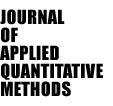 |
|
|||
JAQM Volume 15, Issue 2 - December 30, 2020
Contents
Predicting the total number of confirmed cases in Bucharest using the Prophet package in R
Andreea MIRICA, Marian NECULA, Bogdan Ionut CHIPER
Considering the importance of predictable data based on tested methodology, the present study was focused on validating the usage of open source software R and the open source package PROPHET to estimate future number of COVID-19 cases in Bucharest. A time series of real cases over sixty days in April-June 2020 interval was used to predict the cases over next seven days. The source code used generated results with a Mean Absolute Percentage Error of 0.026
Quantitative methods in healthcare
Fares Hamad ALJOHANI
It is not easy to make decisions in healthcare. Using quantitative methods in healthcare makes a decision more accurate. There are different quantitative methods that are used to make a decision in healthcare. This survey paper discusses five different quantitative methods in healthcare which are: queueing theory techniques, Program Evaluation Review, Root cause analysis, decision tree and forecasting method. This paper surveys different quantitative methods applied in different scenarios in the field of healthcare.
What does /does not Covid-19 Data Tell Us So Far?
Ebru KESKIN, Mehmet MENDES
The detailed analysis of the data about Covid-19 virus is extremely important in terms of both getting to know the virus better, producing information about its mechanism of action and evaluating countries in terms of confirmed, death and recovered cases. Because, by using information produced from data sets, it will be possible to make some predictions for and to determine strategies for future. In this study, Covid-19 data of 20 countries between 6 May and 7 July were evaluated. As a result of the evaluations, it has been observed that the countries display a different structure in terms of confirmed, deaths and recovered cases. It was observed that US, Brazil, India, and Russia were the countries have highest numbers of confirmed cases. However, death rates of these countries are obviously lesser than especially that of the United Kingdom, France, Italy, Mexico, Spain, and Canada. This situation can provide important information for evaluating the health infrastructures of the countries and measures taken by them. Thus, although the numbers of cases of US, Brazil, India and Russia are very high, the death rates of these countries are low. As a result, it is possible to conclude that the measures taken and treatment methods applied in these countries for Covid-19 are more effective or successful.

